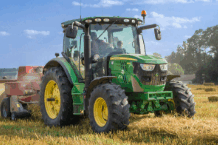Control broadleaf weeds in lawns now, says K-State horticulture expert
The best time to eliminate weeds is while they’re growing
MANHATTAN, Kan. – Many common broadleaf weeds in lawns may not be popping their heads up high right now, but late October and early November is the best time to do battle with them.
Dandelions typically produce a flush of new plants in late September, and winter annual weeds henbit and chickweed should have germinated in October, said Kansas State University horticulture expert Ward Upham.
“These young plants are small and easily controlled with herbicides such as 2,4-D or combination products — such as Trimec, Weed-B-Gon, Weed-Out — that contain 2,4-D, MCPP and dicamba,” Upham said.
“Even established dandelions are more easily controlled now than in the spring because they are actively moving materials from the top portion of the plant to the roots in the fall,” he said. “Herbicides will translocate to the roots as well, and will kill the plant from the roots up.”
Upham said homeowners should apply the products according to label instructions.
“Choose a day that is 50 degrees or higher,” he said. “The better the weed is growing, the more weed killer will be moved from the leaves to the roots. Cold temperatures will slow this product, even though these product will still work at lower temperatures.”
One product – Weed Free Zone (also sold under the name Speed Zone) contains all three active ingredients conducive to killing unwanted weeds, Upham said. “It will give a quicker response than the other product, especially if temperature are below 50 degrees.”
Lawn seedings
Upham also noted that the time may have passed to successfully plant new grass seed.
“We normally recommend that Kentucky bluegrass and tall fescue (two species common in Kansas) be seeded in September. Kentucky bluegrass should be seeded no later than Sept. 30 but tall fescue seeded no later than Oct. 15,” Upham said. “Though plantings later than these dates can be successful, the odds of success diminish as time passes.”
Upham said the problem with late plantings is that the young plants do not have enough time to establish an extensive root system before the winter’s freeze. That, followed by thawing, “heaves plants out of the ground and they dry out and die,” he said.
“Regardless of when planted, be sure the new lawn is kept watered through the fall. More mature lawns will need less frequent watering, but all should go into the winter with moist soil.”
Upham and his colleagues in K-State’s Department of Horticulture and Natural Resources produce a weekly Horticulture Newsletter with tips for maintaining home landscapes. The newsletter is available to view online or can be delivered by email each week.
Interested persons can also send their garden- and yard-related questions to Upham at wupham@ksu.edu, or contact your local K-State Research and Extension office.
Note: Brand names used in this article are used for identification purposes only and are not intended as an endorsement for any specific product.
-30-
FOR PRINT PUBLICATIONS: Links used in this story
K-State Horticulture Newsletter, https://hnr.k-state.edu/extension/info-center/newsletters/index.html
K-State Research and Extension local offices, www.ksre.k-state.edu/about/stateandareamaps.html
K‑State Research and Extension is a short name for the Kansas State University Agricultural Experiment Station and Cooperative Extension Service, a program designed to generate and distribute useful knowledge for the well‑being of Kansans. Supported by county, state, federal and private funds, the program has county extension offices, experiment fields, area extension offices and regional research centers statewide. Its headquarters is on the K‑State campus in Manhattan. For more information, visit www.ksre.ksu.edu. K-State Research and Extension is an equal opportunity provider and employer.
Story by:
Pat Melgares
785-532-1160
For more information:
Ward Upham
785-532-6173



